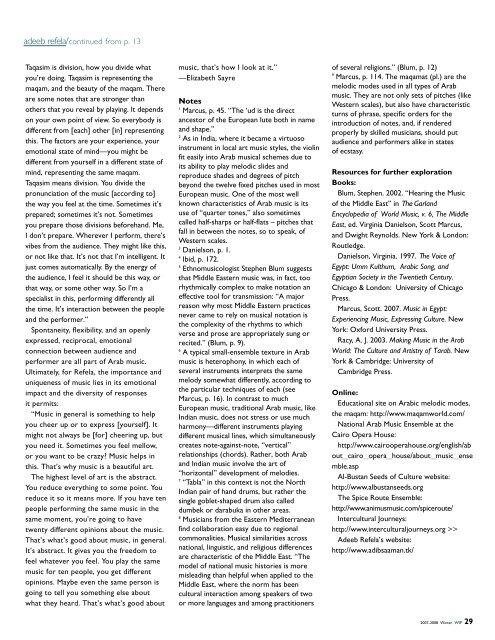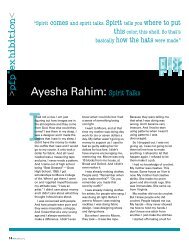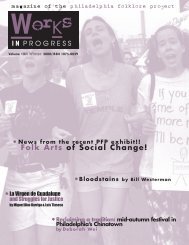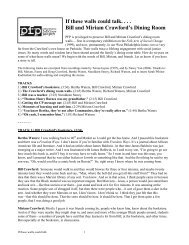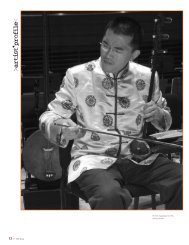African song / Fatu Gayflor ⢠War and wealth - Philadelphia Folklore ...
African song / Fatu Gayflor ⢠War and wealth - Philadelphia Folklore ...
African song / Fatu Gayflor ⢠War and wealth - Philadelphia Folklore ...
Create successful ePaper yourself
Turn your PDF publications into a flip-book with our unique Google optimized e-Paper software.
adeeb refela/continued from p. 13<br />
Taqasim is division, how you divide what<br />
you’re doing. Taqasim is representing the<br />
maqam, <strong>and</strong> the beauty of the maqam. There<br />
are some notes that are stronger than<br />
others that you reveal by playing. It depends<br />
on your own point of view. So everybody is<br />
different from [each] other [in] representing<br />
this. The factors are your experience, your<br />
emotional state of mind—you might be<br />
different from yourself in a different state of<br />
mind, representing the same maqam.<br />
Taqasim means division. You divide the<br />
pronunciation of the music [according to]<br />
the way you feel at the time. Sometimes it’s<br />
prepared; sometimes it’s not. Sometimes<br />
you prepare those divisions beforeh<strong>and</strong>. Me,<br />
I don’t prepare. Wherever I perform, there’s<br />
vibes from the audience. They might like this,<br />
or not like that. It’s not that I’m intelligent. It<br />
just comes automatically. By the energy of<br />
the audience, I feel it should be this way, or<br />
that way, or some other way. So I’m a<br />
specialist in this, performing differently all<br />
the time. It’s interaction between the people<br />
<strong>and</strong> the performer.”<br />
Spontaneity, flexibility, <strong>and</strong> an openly<br />
expressed, reciprocal, emotional<br />
connection between audience <strong>and</strong><br />
performer are all part of Arab music.<br />
Ultimately, for Refela, the importance <strong>and</strong><br />
uniqueness of music lies in its emotional<br />
impact <strong>and</strong> the diversity of responses<br />
it permits:<br />
“Music in general is something to help<br />
you cheer up or to express [yourself]. It<br />
might not always be [for] cheering up, but<br />
you need it. Sometimes you feel mellow,<br />
or you want to be crazy? Music helps in<br />
this. That’s why music is a beautiful art.<br />
The highest level of art is the abstract.<br />
You reduce everything to some point. You<br />
reduce it so it means more. If you have ten<br />
people performing the same music in the<br />
same moment, you’re going to have<br />
twenty different opinions about the music.<br />
That’s what’s good about music, in general.<br />
It’s abstract. It gives you the freedom to<br />
feel whatever you feel. You play the same<br />
music for ten people, you get different<br />
opinions. Maybe even the same person is<br />
going to tell you something else about<br />
what they heard. That’s what’s good about<br />
music, that’s how I look at it.”<br />
—Elizabeth Sayre<br />
Notes<br />
1<br />
Marcus, p. 45. “The ‘ud is the direct<br />
ancestor of the European lute both in name<br />
<strong>and</strong> shape.”<br />
2<br />
As in India, where it became a virtuoso<br />
instrument in local art music styles, the violin<br />
fit easily into Arab musical schemes due to<br />
its ability to play melodic slides <strong>and</strong><br />
reproduce shades <strong>and</strong> degrees of pitch<br />
beyond the twelve fixed pitches used in most<br />
European music. One of the most well<br />
known characteristics of Arab music is its<br />
use of “quarter tones,” also sometimes<br />
called half-sharps or half-flats – pitches that<br />
fall in between the notes, so to speak, of<br />
Western scales.<br />
3<br />
Danielson, p. 1.<br />
4<br />
Ibid, p. 172.<br />
5<br />
Ethnomusicologist Stephen Blum suggests<br />
that Middle Eastern music was, in fact, too<br />
rhythmically complex to make notation an<br />
effective tool for transmission: “A major<br />
reason why most Middle Eastern practices<br />
never came to rely on musical notation is<br />
the complexity of the rhythms to which<br />
verse <strong>and</strong> prose are appropriately sung or<br />
recited.” (Blum, p. 9).<br />
6<br />
A typical small-ensemble texture in Arab<br />
music is heterophony, in which each of<br />
several instruments interprets the same<br />
melody somewhat differently, according to<br />
the particular techniques of each (see<br />
Marcus, p. 16). In contrast to much<br />
European music, traditional Arab music, like<br />
Indian music, does not stress or use much<br />
harmony—different instruments playing<br />
different musical lines, which simultaneously<br />
creates note-against-note, “vertical”<br />
relationships (chords). Rather, both Arab<br />
<strong>and</strong> Indian music involve the art of<br />
“horizontal” development of melodies.<br />
7<br />
“Tabla” in this context is not the North<br />
Indian pair of h<strong>and</strong> drums, but rather the<br />
single goblet-shaped drum also called<br />
dumbek or darabuka in other areas.<br />
8<br />
Musicians from the Eastern Mediterranean<br />
find collaboration easy due to regional<br />
commonalities. Musical similarities across<br />
national, linguistic, <strong>and</strong> religious differences<br />
are characteristic of the Middle East. “The<br />
model of national music histories is more<br />
misleading than helpful when applied to the<br />
Middle East, where the norm has been<br />
cultural interaction among speakers of two<br />
or more languages <strong>and</strong> among practitioners<br />
of several religions.” (Blum, p. 12)<br />
9<br />
Marcus, p. 114. The maqamat (pl.) are the<br />
melodic modes used in all types of Arab<br />
music. They are not only sets of pitches (like<br />
Western scales), but also have characteristic<br />
turns of phrase, specific orders for the<br />
introduction of notes, <strong>and</strong>, if rendered<br />
properly by skilled musicians, should put<br />
audience <strong>and</strong> performers alike in states<br />
of ecstasy.<br />
Resources for further exploration<br />
Books:<br />
Blum, Stephen. 2002. “Hearing the Music<br />
of the Middle East” in The Garl<strong>and</strong><br />
Encyclopedia of World Music, v. 6, The Middle<br />
East, ed. Virginia Danielson, Scott Marcus,<br />
<strong>and</strong> Dwight Reynolds. New York & London:<br />
Routledge.<br />
Danielson, Virginia. 1997. The Voice of<br />
Egypt: Umm Kulthum, Arabic Song, <strong>and</strong><br />
Egyptian Society in the Twentieth Century.<br />
Chicago & London: University of Chicago<br />
Press.<br />
Marcus, Scott. 2007. Music in Egypt:<br />
Experiencing Music, Expressing Culture. New<br />
York: Oxford University Press.<br />
Racy, A. J. 2003. Making Music in the Arab<br />
World: The Culture <strong>and</strong> Artistry of Tarab. New<br />
York & Cambridge: University of<br />
Cambridge Press.<br />
Online:<br />
Educational site on Arabic melodic modes,<br />
the maqam: http://www.maqamworld.com/<br />
National Arab Music Ensemble at the<br />
Cairo Opera House:<br />
http://www.cairooperahouse.org/english/ab<br />
out_cairo_opera_house/about_music_ense<br />
mble.asp<br />
Al-Bustan Seeds of Culture website:<br />
http://www.albustanseeds.org<br />
The Spice Route Ensemble:<br />
http://www.animusmusic.com/spiceroute/<br />
Intercultural Journeys:<br />
http://www.interculturaljourneys.org >><br />
Adeeb Refela’s website:<br />
http://www.adibsaaman.tk/<br />
2007-2008 Winter WIP 29


